Why More Female Leaders Won’t Lead to More Peace

Published by The Lawfare Institute
in Cooperation With

Editor’s Note: Are female leaders less likely to go to war? Joshua Schwartz of Carnegie Mellon and Princeton's Christopher Blair argue that while, in general, women may have more pacifistic learnings than men, women leaders face strong political incentives to be more warlike.
Dan Byman
—
The world has seen an explosion of violent conflict in recent years. From Russia’s invasion of Ukraine—the largest war in Europe since World War II—to Azerbaijan’s seizure of the disputed territory of Nagorno-Karabakh, the Tigray war in Ethiopia, and the Israel-Hamas war, the number and severity of wars is the highest it has been in decades. This trend may get even worse as U.S.-China competition intensifies and climate change exacerbates conflict.
Almost all the countries going to war today are led by men. Might more women in leadership positions help to avert these kinds of conflicts?
Many policymakers, academics, business leaders, and celebrities believe the answer to this question is yes. Former President Obama said that women executives are “pretty indisputably … better than [men]” and that with more women leaders in high political offices worldwide “there would be less war.” In a prominent book about why violence has declined over time, Harvard psychologist Steven Pinker said, “Over the long sweep of history, women have been and will be a pacifying force. Traditional war is a man’s game.” Former Meta Chief Operating Officer Sheryl Sandberg said, “No two countries run by women would ever go to war.” Even comedian Will Ferrell asked recently whether “it [is] just time for women to run the planet” since men are “not doing so good.”
Is the conventional wisdom correct? Would a world with more women leaders be a more peaceful one? Given that Kamala Harris is vice president to the oldest president in American history, and women politicians have made serious runs for the presidency in recent years, this question is particularly germane for the future of U.S. foreign policy.
Unfortunately, our research demonstrates that this optimism should be met with skepticism. Due to the gender-based discrimination women leaders face among the U.S. public, they have political incentives to present themselves as “iron ladies” rather than peacemakers, and to eschew—not pursue—peace with foreign adversaries.
Gender Stereotypes and Foreign Policy
Public polling has consistently demonstrated a gender gap in support for the use of force abroad. Whether due to socialization or bio-evolutionary factors, women members of the public are generally more likely to want peace, and this has fueled hope that a world with more women leaders would be more peaceful.
However, gender stereotypes that women are more inclined toward peace—and less competent and resolved in the realm of national security—create a dynamic that gives women leaders political incentives to “act tough” in foreign affairs. For example, Geraldine Ferraro—the only female Democratic vice presidential candidate before Kamala Harris—was asked at the vice presidential debate in 1984 whether she thought “that the Soviets might be tempted to try and take advantage of [her] simply because [she was] a woman.” Similar questions dogged her entire campaign. In a follow-up on “Meet the Press,” hosts questioned whether Ferraro was “strong enough to push the [nuclear] button.” While that was almost 40 years ago, and Harris did not face as overtly sexist questions about her foreign policy credentials during the 2020 campaign, polls taken in 2008, 2018, and 2020 continue to show that many Americans still believe that men are better equipped than women to handle national security issues. It’s not just the United States: Across more than 80 countries, polling reveals a preference for male leadership in times of threat. These attitudes are rooted in gender stereotypes that women are weak and passive, while men are strong and aggressive.
Consequently, even if women leaders are more likely to want peace, they face political incentives to combat gender-stereotypical expectations of weakness by adopting relatively hawkish policies. It is therefore no surprise that we observe “iron ladies” throughout history, from Margaret Thatcher and Golda Meir to Indira Gandhi and Tansu Çiller. Even in the United States, high-ranking women foreign policymakers like Madeleine Albright, Jeane Kirkpatrick, Condoleezza Rice, and Hillary Clinton often advocated more aggressive foreign policies than their male counterparts. Nikki Haley similarly adopted a more hawkish foreign policy platform than her male competitors during the recent Republican presidential primaries.
Our research points to three specific incentives female executives have to pursue relatively hard-line policies: avoid pursuing peace, be aggressive, and don’t back down.
Avoid Pursuing Peace
“Only Nixon could go to China.” The logic of this adage is that it is harder, from a domestic political perspective, for dovish leaders to pursue peace with foreign adversaries than for hawks like Nixon to do so. Since doves are perceived as predisposed toward wanting peace, their attempts at rapprochement are met with greater skepticism among members of the U.S. public. The public questions whether dovish leaders are pursuing peace because it is truly in the national interest or simply because they are ideologically inclined toward reconciliation.
Polling we conducted on the American public indicates it would be similarly difficult for a female leader to (metaphorically) “go to China.” In August 2021, we fielded a nationally representative survey experiment that introduced respondents to a hypothetical scenario set in 2027 involving heightened tensions between the U.S. and China. We then randomly varied whether the president was a man or a woman and whether the president chose to pursue rapprochement with China.
The results were striking. Women leaders were punished over 11 percentage points more than male leaders for pursuing identical reconciliation policies toward China. The discrimination women leaders face for attempting rapprochement disincentivizes them from pursuing peace in the first place and limits the degree to which they can effectively carry out their preferred foreign policy agendas in office.
Real-world evidence from formerly confidential interviews known as the “Afghanistan Papers” also illustrates this dynamic. Barnett Rubin—the senior adviser to the special representative for Afghanistan and Pakistan in the Obama administration—noted the following of then-Secretary of State Hillary Clinton: “S[he] was very reluctant to move on [peace with the Taliban] …. If you want to be the first woman president you cannot leave any hint or doubt that you’re not the toughest person on national security.”
Be Aggressive
The inverse of women leaders having political incentives to eschew peace is that they also have political incentives to act tough during international crises. Specifically, our research shows the American public is more supportive of military threats issued by women leaders than identical threats issued by male leaders.
We provided evidence for this dynamic in another nationally representative survey experiment we conducted in 2019. Participants were presented with a hypothetical scenario involving the invasion of a foreign country. We again randomly varied whether the U.S. president was a man or a woman, in addition to whether the president issued a military threat to push out the invaders and whether the president followed through on the threat.
Again, the results were striking: Women presidents were punished about 14 percentage points less than male leaders for making identical military threats. This indicates women leaders have political incentives to be assertive and belligerent in international crises rather than pacific.
Don’t Back Down
In the same experiment described above, we demonstrated that women leaders are punished disproportionately if they act inconsistently and back down from threats they previously issued. Disapproval is about 20 percentage points higher among the American public when women executives make a threat and back down than when male leaders take the same action. The logic is that backing down activates gender stereotypes about women’s “lack of fit” for the role of commander in chief and confirms harmful, stereotypical misperceptions of women’s foreign policy ineptitude.
The costs of backing down confer both disadvantages and theoretical advantages for women leaders. On the negative side, women presidents will find it politically more difficult to back down from threats, which could make it harder to deescalate crises. On the positive side, this should theoretically make a woman president’s threats more credible to foreign enemies, since she is less likely to back down (for fear of domestic backlash at the polls). Of course, this relies on adversaries understanding these dynamics and not themselves believing in gender stereotypes that women are more likely to back down.
Finally, our study shows that the increasing presence of women in executive offices around the world also matters for men. Male leaders are punished disproportionately if they make a threat and fail to uphold it when the foreign leader they threaten is a woman. This kind of dynamic is evident even in schoolyard disputes, where “you lost to a girl” is a common pejorative.
If women leaders are punished for backing down, and male leaders are punished for backing down against female opponents, then greater female leadership, regrettably, may not have the dramatic pacifying effect that many optimists believe. There are many advantages to having more women executives, and it is high time we take a firm stand against discrimination and other barriers to women’s entry in politics. Unfortunately, greater women’s leadership is unlikely to be the panacea for peace that many hope, at least in the short term while gender discrimination continues to exist.





